Comprehensive Report on Sustainability in the Pharmaceutical Industry
VerifiedAdded on 2020/12/18
|14
|3353
|444
Report
AI Summary
This report provides an in-depth analysis of the pharmaceutical industry's approach to sustainability. It begins with an introduction to the industry's role in healthcare and its impact on the global economy, then transitions to a discussion of the main body, which covers the industry's operational and strategic opportunities and challenges in the field of sustainability. The report explores the concept of sustainability within the context of the pharmaceutical sector, highlighting the importance of environmental, social, and economic factors. It details the challenges faced by the industry in ensuring sustainable practices, such as lack of awareness, government support, and funding. Furthermore, the report outlines the opportunities available for pharmaceutical companies to enhance sustainability, including lean practices and the adoption of new technologies. The report also discusses the role of corporate social responsibility (CSR), industry stakeholders, and the future of the pharmaceutical industry in a sustainable context. The conclusion summarizes the key findings and the importance of sustainable practices for the pharmaceutical industry's long-term success.
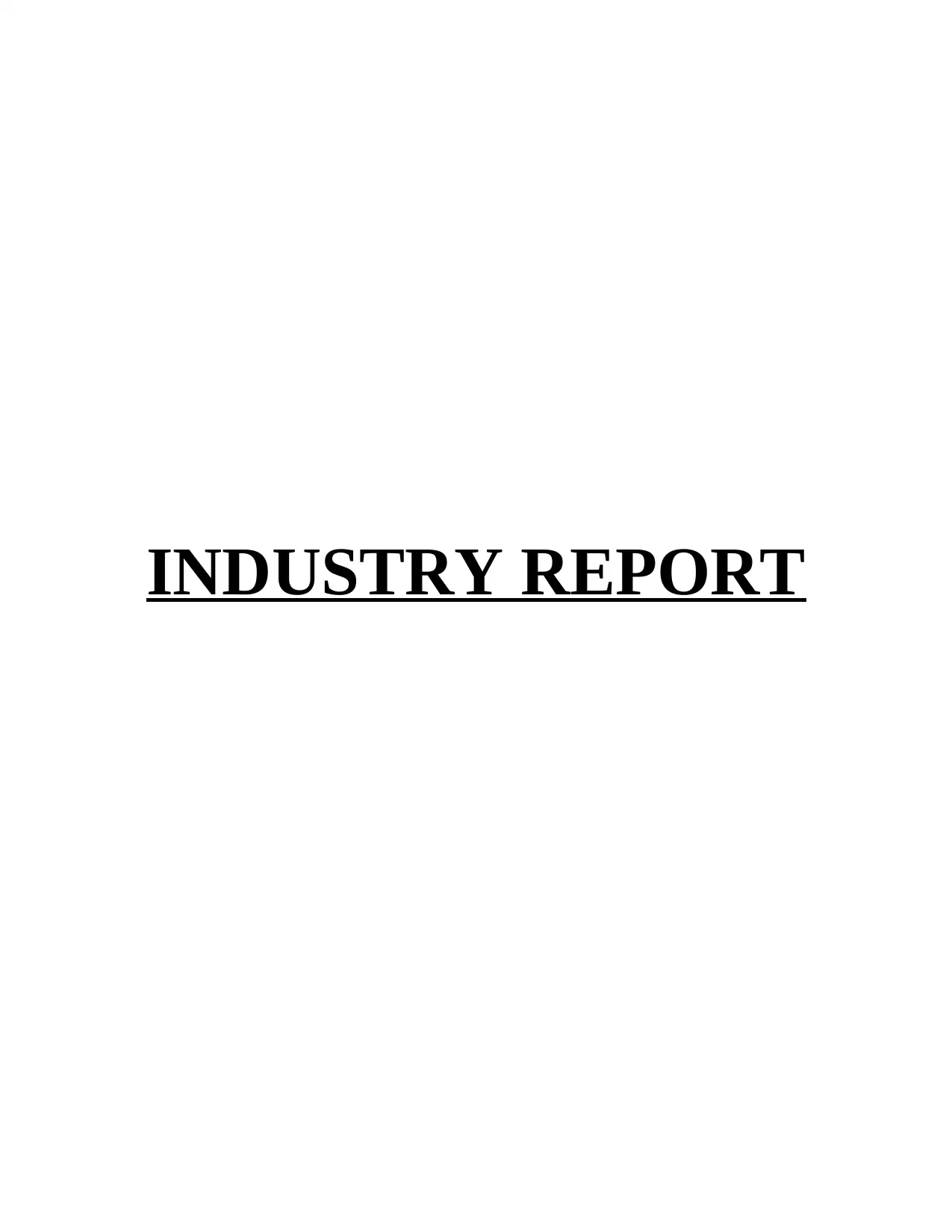
INDUSTRY REPORT
Paraphrase This Document
Need a fresh take? Get an instant paraphrase of this document with our AI Paraphraser

TABLE OF CONTENTS
INTRODUCTION...........................................................................................................................1
MAIN BODY...................................................................................................................................1
Pharmaceuticals and Sustainability.............................................................................................3
Challenges faced by Pharmaceutical industry in ensuring sustainability...................................4
Opportunities for Pharmaceutical industry in sustainability.......................................................5
Corporate Social Responsibility in Pharmaceutical Industry......................................................6
Industry's Stakeholders and its future.........................................................................................7
CONCLUSION................................................................................................................................8
REFERENCES................................................................................................................................9
INTRODUCTION...........................................................................................................................1
MAIN BODY...................................................................................................................................1
Pharmaceuticals and Sustainability.............................................................................................3
Challenges faced by Pharmaceutical industry in ensuring sustainability...................................4
Opportunities for Pharmaceutical industry in sustainability.......................................................5
Corporate Social Responsibility in Pharmaceutical Industry......................................................6
Industry's Stakeholders and its future.........................................................................................7
CONCLUSION................................................................................................................................8
REFERENCES................................................................................................................................9
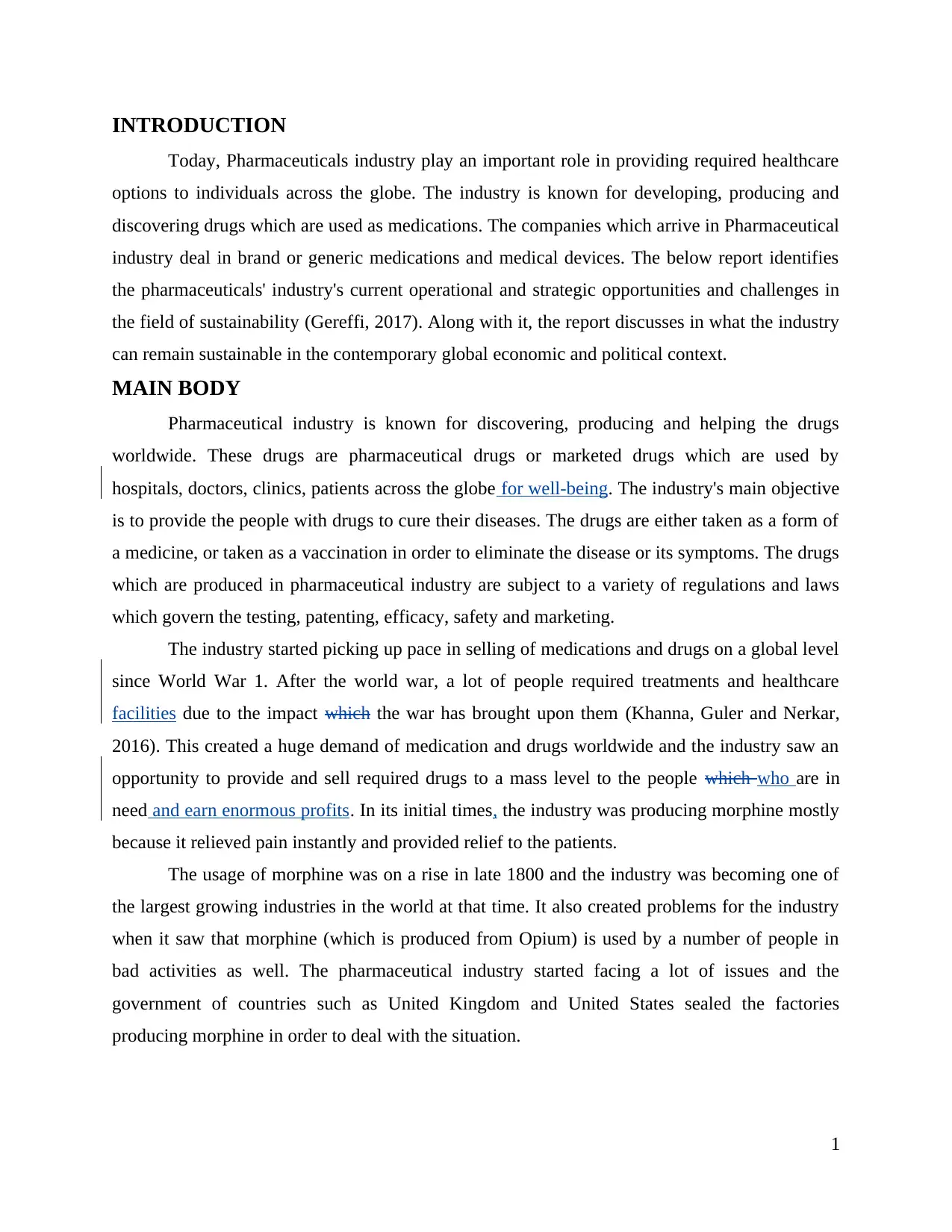
INTRODUCTION
Today, Pharmaceuticals industry play an important role in providing required healthcare
options to individuals across the globe. The industry is known for developing, producing and
discovering drugs which are used as medications. The companies which arrive in Pharmaceutical
industry deal in brand or generic medications and medical devices. The below report identifies
the pharmaceuticals' industry's current operational and strategic opportunities and challenges in
the field of sustainability (Gereffi, 2017). Along with it, the report discusses in what the industry
can remain sustainable in the contemporary global economic and political context.
MAIN BODY
Pharmaceutical industry is known for discovering, producing and helping the drugs
worldwide. These drugs are pharmaceutical drugs or marketed drugs which are used by
hospitals, doctors, clinics, patients across the globe for well-being. The industry's main objective
is to provide the people with drugs to cure their diseases. The drugs are either taken as a form of
a medicine, or taken as a vaccination in order to eliminate the disease or its symptoms. The drugs
which are produced in pharmaceutical industry are subject to a variety of regulations and laws
which govern the testing, patenting, efficacy, safety and marketing.
The industry started picking up pace in selling of medications and drugs on a global level
since World War 1. After the world war, a lot of people required treatments and healthcare
facilities due to the impact which the war has brought upon them (Khanna, Guler and Nerkar,
2016). This created a huge demand of medication and drugs worldwide and the industry saw an
opportunity to provide and sell required drugs to a mass level to the people which who are in
need and earn enormous profits. In its initial times, the industry was producing morphine mostly
because it relieved pain instantly and provided relief to the patients.
The usage of morphine was on a rise in late 1800 and the industry was becoming one of
the largest growing industries in the world at that time. It also created problems for the industry
when it saw that morphine (which is produced from Opium) is used by a number of people in
bad activities as well. The pharmaceutical industry started facing a lot of issues and the
government of countries such as United Kingdom and United States sealed the factories
producing morphine in order to deal with the situation.
1
Today, Pharmaceuticals industry play an important role in providing required healthcare
options to individuals across the globe. The industry is known for developing, producing and
discovering drugs which are used as medications. The companies which arrive in Pharmaceutical
industry deal in brand or generic medications and medical devices. The below report identifies
the pharmaceuticals' industry's current operational and strategic opportunities and challenges in
the field of sustainability (Gereffi, 2017). Along with it, the report discusses in what the industry
can remain sustainable in the contemporary global economic and political context.
MAIN BODY
Pharmaceutical industry is known for discovering, producing and helping the drugs
worldwide. These drugs are pharmaceutical drugs or marketed drugs which are used by
hospitals, doctors, clinics, patients across the globe for well-being. The industry's main objective
is to provide the people with drugs to cure their diseases. The drugs are either taken as a form of
a medicine, or taken as a vaccination in order to eliminate the disease or its symptoms. The drugs
which are produced in pharmaceutical industry are subject to a variety of regulations and laws
which govern the testing, patenting, efficacy, safety and marketing.
The industry started picking up pace in selling of medications and drugs on a global level
since World War 1. After the world war, a lot of people required treatments and healthcare
facilities due to the impact which the war has brought upon them (Khanna, Guler and Nerkar,
2016). This created a huge demand of medication and drugs worldwide and the industry saw an
opportunity to provide and sell required drugs to a mass level to the people which who are in
need and earn enormous profits. In its initial times, the industry was producing morphine mostly
because it relieved pain instantly and provided relief to the patients.
The usage of morphine was on a rise in late 1800 and the industry was becoming one of
the largest growing industries in the world at that time. It also created problems for the industry
when it saw that morphine (which is produced from Opium) is used by a number of people in
bad activities as well. The pharmaceutical industry started facing a lot of issues and the
government of countries such as United Kingdom and United States sealed the factories
producing morphine in order to deal with the situation.
1
⊘ This is a preview!⊘
Do you want full access?
Subscribe today to unlock all pages.

Trusted by 1+ million students worldwide
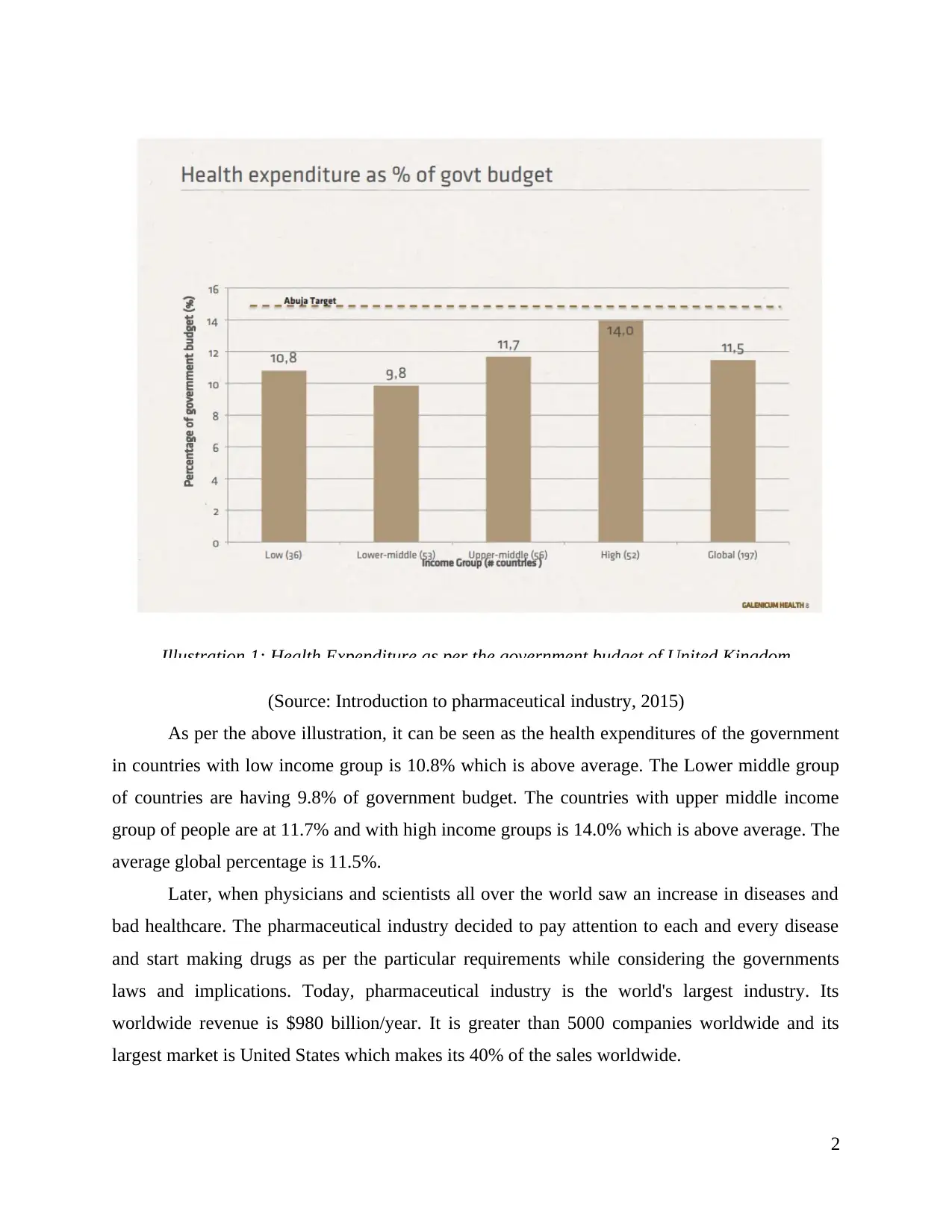
(Source: Introduction to pharmaceutical industry, 2015)
As per the above illustration, it can be seen as the health expenditures of the government
in countries with low income group is 10.8% which is above average. The Lower middle group
of countries are having 9.8% of government budget. The countries with upper middle income
group of people are at 11.7% and with high income groups is 14.0% which is above average. The
average global percentage is 11.5%.
Later, when physicians and scientists all over the world saw an increase in diseases and
bad healthcare. The pharmaceutical industry decided to pay attention to each and every disease
and start making drugs as per the particular requirements while considering the governments
laws and implications. Today, pharmaceutical industry is the world's largest industry. Its
worldwide revenue is $980 billion/year. It is greater than 5000 companies worldwide and its
largest market is United States which makes its 40% of the sales worldwide.
2
Illustration 1: Health Expenditure as per the government budget of United Kingdom
As per the above illustration, it can be seen as the health expenditures of the government
in countries with low income group is 10.8% which is above average. The Lower middle group
of countries are having 9.8% of government budget. The countries with upper middle income
group of people are at 11.7% and with high income groups is 14.0% which is above average. The
average global percentage is 11.5%.
Later, when physicians and scientists all over the world saw an increase in diseases and
bad healthcare. The pharmaceutical industry decided to pay attention to each and every disease
and start making drugs as per the particular requirements while considering the governments
laws and implications. Today, pharmaceutical industry is the world's largest industry. Its
worldwide revenue is $980 billion/year. It is greater than 5000 companies worldwide and its
largest market is United States which makes its 40% of the sales worldwide.
2
Illustration 1: Health Expenditure as per the government budget of United Kingdom
Paraphrase This Document
Need a fresh take? Get an instant paraphrase of this document with our AI Paraphraser
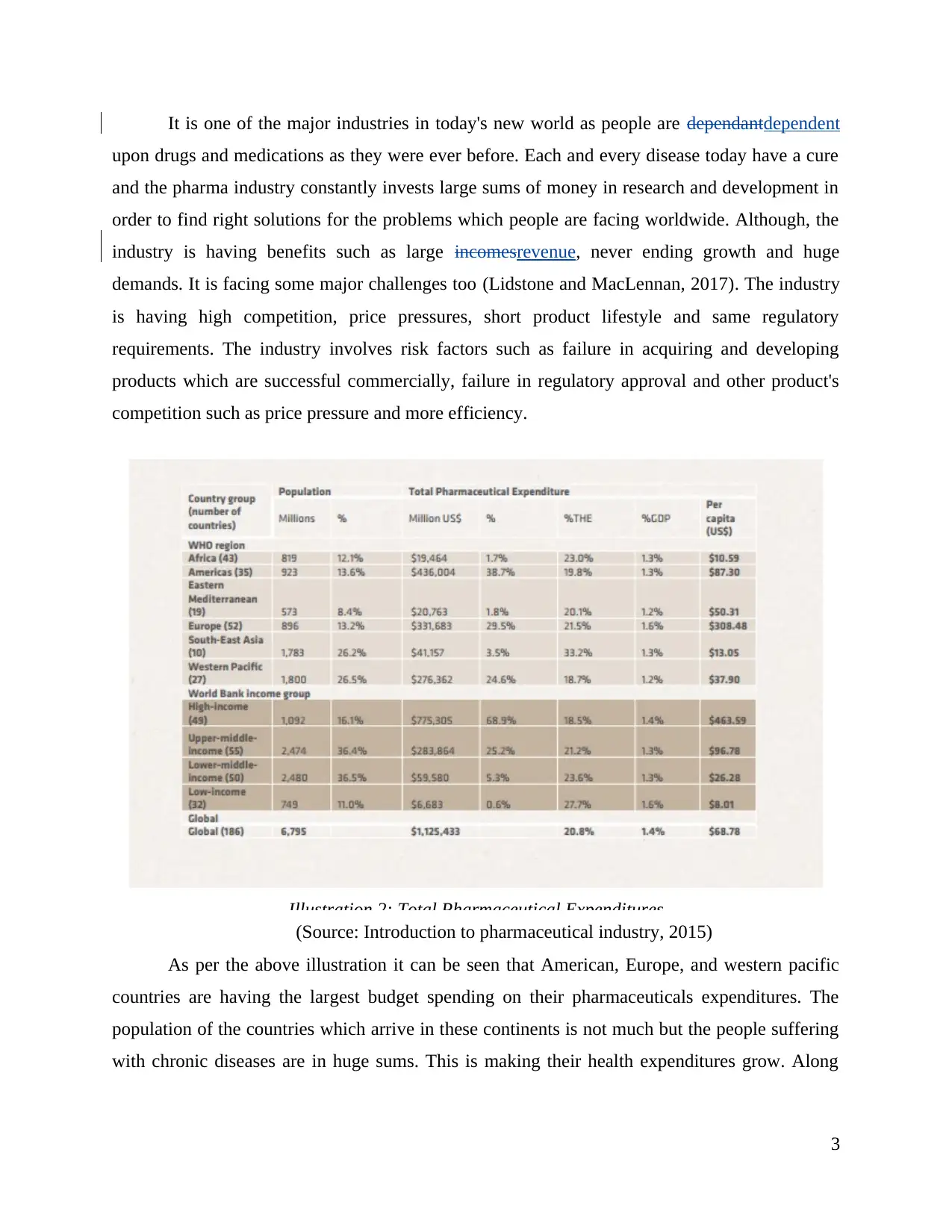
It is one of the major industries in today's new world as people are dependantdependent
upon drugs and medications as they were ever before. Each and every disease today have a cure
and the pharma industry constantly invests large sums of money in research and development in
order to find right solutions for the problems which people are facing worldwide. Although, the
industry is having benefits such as large incomesrevenue, never ending growth and huge
demands. It is facing some major challenges too (Lidstone and MacLennan, 2017). The industry
is having high competition, price pressures, short product lifestyle and same regulatory
requirements. The industry involves risk factors such as failure in acquiring and developing
products which are successful commercially, failure in regulatory approval and other product's
competition such as price pressure and more efficiency.
(Source: Introduction to pharmaceutical industry, 2015)
As per the above illustration it can be seen that American, Europe, and western pacific
countries are having the largest budget spending on their pharmaceuticals expenditures. The
population of the countries which arrive in these continents is not much but the people suffering
with chronic diseases are in huge sums. This is making their health expenditures grow. Along
3
Illustration 2: Total Pharmaceutical Expenditures
upon drugs and medications as they were ever before. Each and every disease today have a cure
and the pharma industry constantly invests large sums of money in research and development in
order to find right solutions for the problems which people are facing worldwide. Although, the
industry is having benefits such as large incomesrevenue, never ending growth and huge
demands. It is facing some major challenges too (Lidstone and MacLennan, 2017). The industry
is having high competition, price pressures, short product lifestyle and same regulatory
requirements. The industry involves risk factors such as failure in acquiring and developing
products which are successful commercially, failure in regulatory approval and other product's
competition such as price pressure and more efficiency.
(Source: Introduction to pharmaceutical industry, 2015)
As per the above illustration it can be seen that American, Europe, and western pacific
countries are having the largest budget spending on their pharmaceuticals expenditures. The
population of the countries which arrive in these continents is not much but the people suffering
with chronic diseases are in huge sums. This is making their health expenditures grow. Along
3
Illustration 2: Total Pharmaceutical Expenditures
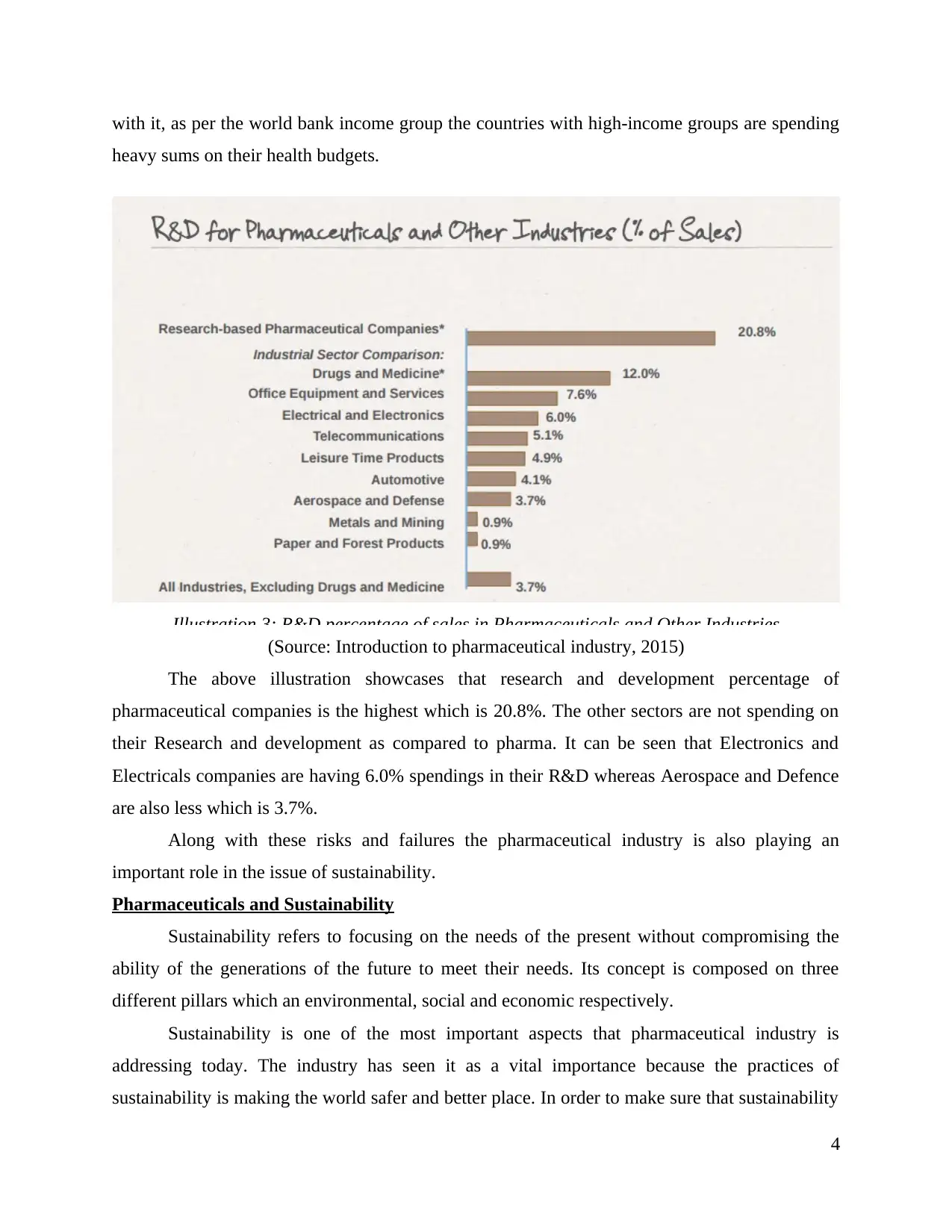
with it, as per the world bank income group the countries with high-income groups are spending
heavy sums on their health budgets.
(Source: Introduction to pharmaceutical industry, 2015)
The above illustration showcases that research and development percentage of
pharmaceutical companies is the highest which is 20.8%. The other sectors are not spending on
their Research and development as compared to pharma. It can be seen that Electronics and
Electricals companies are having 6.0% spendings in their R&D whereas Aerospace and Defence
are also less which is 3.7%.
Along with these risks and failures the pharmaceutical industry is also playing an
important role in the issue of sustainability.
Pharmaceuticals and Sustainability
Sustainability refers to focusing on the needs of the present without compromising the
ability of the generations of the future to meet their needs. Its concept is composed on three
different pillars which an environmental, social and economic respectively.
Sustainability is one of the most important aspects that pharmaceutical industry is
addressing today. The industry has seen it as a vital importance because the practices of
sustainability is making the world safer and better place. In order to make sure that sustainability
4
Illustration 3: R&D percentage of sales in Pharmaceuticals and Other Industries
heavy sums on their health budgets.
(Source: Introduction to pharmaceutical industry, 2015)
The above illustration showcases that research and development percentage of
pharmaceutical companies is the highest which is 20.8%. The other sectors are not spending on
their Research and development as compared to pharma. It can be seen that Electronics and
Electricals companies are having 6.0% spendings in their R&D whereas Aerospace and Defence
are also less which is 3.7%.
Along with these risks and failures the pharmaceutical industry is also playing an
important role in the issue of sustainability.
Pharmaceuticals and Sustainability
Sustainability refers to focusing on the needs of the present without compromising the
ability of the generations of the future to meet their needs. Its concept is composed on three
different pillars which an environmental, social and economic respectively.
Sustainability is one of the most important aspects that pharmaceutical industry is
addressing today. The industry has seen it as a vital importance because the practices of
sustainability is making the world safer and better place. In order to make sure that sustainability
4
Illustration 3: R&D percentage of sales in Pharmaceuticals and Other Industries
⊘ This is a preview!⊘
Do you want full access?
Subscribe today to unlock all pages.

Trusted by 1+ million students worldwide
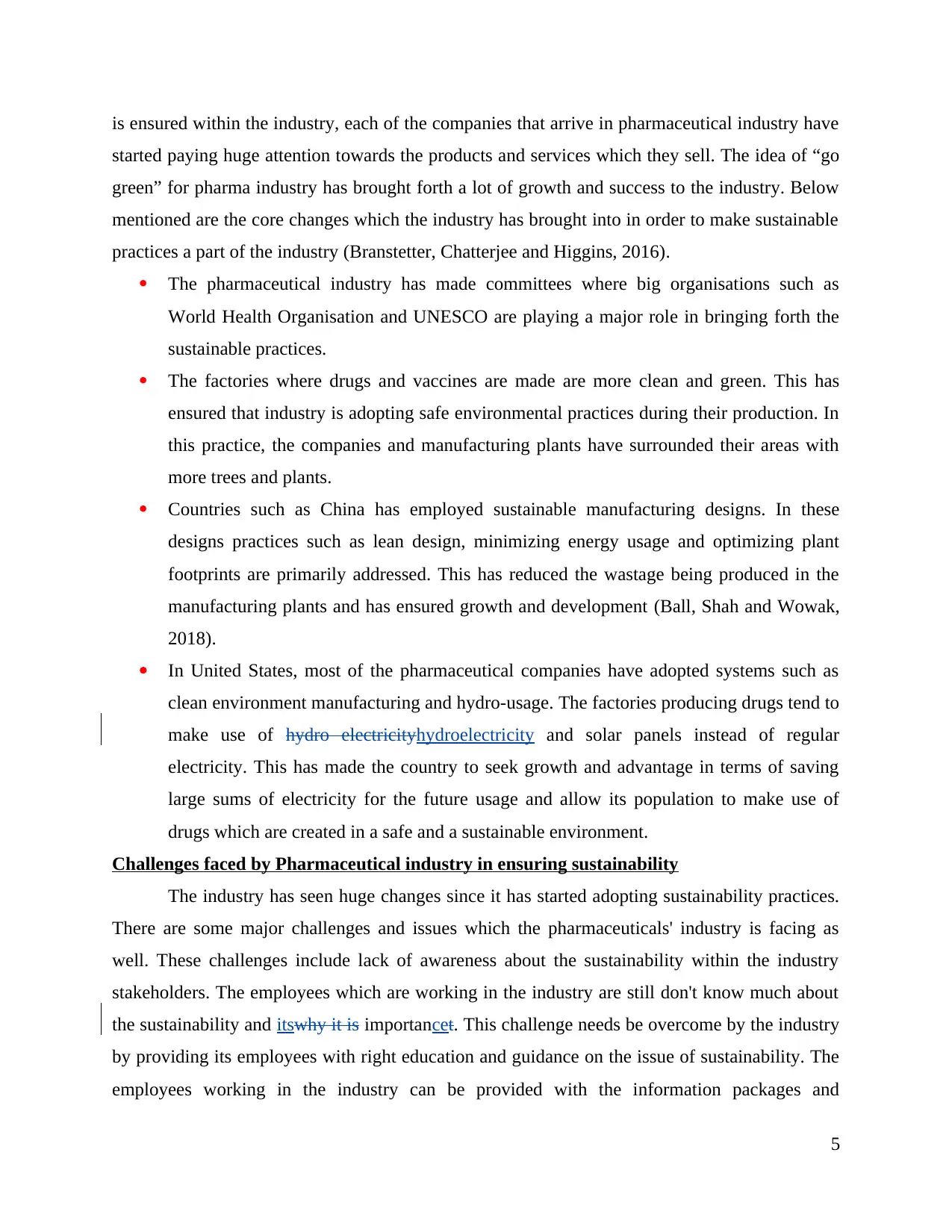
is ensured within the industry, each of the companies that arrive in pharmaceutical industry have
started paying huge attention towards the products and services which they sell. The idea of “go
green” for pharma industry has brought forth a lot of growth and success to the industry. Below
mentioned are the core changes which the industry has brought into in order to make sustainable
practices a part of the industry (Branstetter, Chatterjee and Higgins, 2016).
The pharmaceutical industry has made committees where big organisations such as
World Health Organisation and UNESCO are playing a major role in bringing forth the
sustainable practices.
The factories where drugs and vaccines are made are more clean and green. This has
ensured that industry is adopting safe environmental practices during their production. In
this practice, the companies and manufacturing plants have surrounded their areas with
more trees and plants.
Countries such as China has employed sustainable manufacturing designs. In these
designs practices such as lean design, minimizing energy usage and optimizing plant
footprints are primarily addressed. This has reduced the wastage being produced in the
manufacturing plants and has ensured growth and development (Ball, Shah and Wowak,
2018).
In United States, most of the pharmaceutical companies have adopted systems such as
clean environment manufacturing and hydro-usage. The factories producing drugs tend to
make use of hydro electricityhydroelectricity and solar panels instead of regular
electricity. This has made the country to seek growth and advantage in terms of saving
large sums of electricity for the future usage and allow its population to make use of
drugs which are created in a safe and a sustainable environment.
Challenges faced by Pharmaceutical industry in ensuring sustainability
The industry has seen huge changes since it has started adopting sustainability practices.
There are some major challenges and issues which the pharmaceuticals' industry is facing as
well. These challenges include lack of awareness about the sustainability within the industry
stakeholders. The employees which are working in the industry are still don't know much about
the sustainability and itswhy it is importancet. This challenge needs be overcome by the industry
by providing its employees with right education and guidance on the issue of sustainability. The
employees working in the industry can be provided with the information packages and
5
started paying huge attention towards the products and services which they sell. The idea of “go
green” for pharma industry has brought forth a lot of growth and success to the industry. Below
mentioned are the core changes which the industry has brought into in order to make sustainable
practices a part of the industry (Branstetter, Chatterjee and Higgins, 2016).
The pharmaceutical industry has made committees where big organisations such as
World Health Organisation and UNESCO are playing a major role in bringing forth the
sustainable practices.
The factories where drugs and vaccines are made are more clean and green. This has
ensured that industry is adopting safe environmental practices during their production. In
this practice, the companies and manufacturing plants have surrounded their areas with
more trees and plants.
Countries such as China has employed sustainable manufacturing designs. In these
designs practices such as lean design, minimizing energy usage and optimizing plant
footprints are primarily addressed. This has reduced the wastage being produced in the
manufacturing plants and has ensured growth and development (Ball, Shah and Wowak,
2018).
In United States, most of the pharmaceutical companies have adopted systems such as
clean environment manufacturing and hydro-usage. The factories producing drugs tend to
make use of hydro electricityhydroelectricity and solar panels instead of regular
electricity. This has made the country to seek growth and advantage in terms of saving
large sums of electricity for the future usage and allow its population to make use of
drugs which are created in a safe and a sustainable environment.
Challenges faced by Pharmaceutical industry in ensuring sustainability
The industry has seen huge changes since it has started adopting sustainability practices.
There are some major challenges and issues which the pharmaceuticals' industry is facing as
well. These challenges include lack of awareness about the sustainability within the industry
stakeholders. The employees which are working in the industry are still don't know much about
the sustainability and itswhy it is importancet. This challenge needs be overcome by the industry
by providing its employees with right education and guidance on the issue of sustainability. The
employees working in the industry can be provided with the information packages and
5
Paraphrase This Document
Need a fresh take? Get an instant paraphrase of this document with our AI Paraphraser
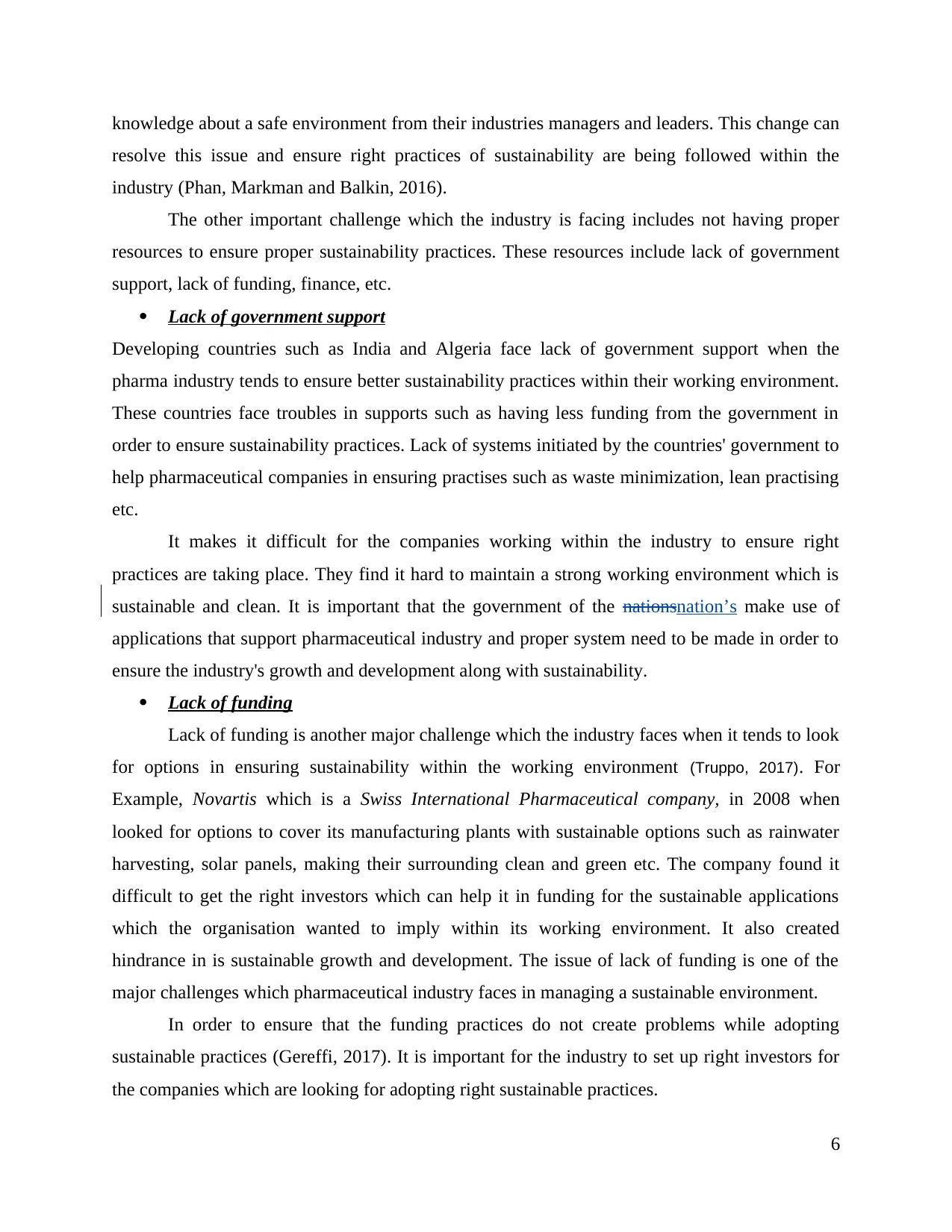
knowledge about a safe environment from their industries managers and leaders. This change can
resolve this issue and ensure right practices of sustainability are being followed within the
industry (Phan, Markman and Balkin, 2016).
The other important challenge which the industry is facing includes not having proper
resources to ensure proper sustainability practices. These resources include lack of government
support, lack of funding, finance, etc.
Lack of government support
Developing countries such as India and Algeria face lack of government support when the
pharma industry tends to ensure better sustainability practices within their working environment.
These countries face troubles in supports such as having less funding from the government in
order to ensure sustainability practices. Lack of systems initiated by the countries' government to
help pharmaceutical companies in ensuring practises such as waste minimization, lean practising
etc.
It makes it difficult for the companies working within the industry to ensure right
practices are taking place. They find it hard to maintain a strong working environment which is
sustainable and clean. It is important that the government of the nationsnation’s make use of
applications that support pharmaceutical industry and proper system need to be made in order to
ensure the industry's growth and development along with sustainability.
Lack of funding
Lack of funding is another major challenge which the industry faces when it tends to look
for options in ensuring sustainability within the working environment (Truppo, 2017). For
Example, Novartis which is a Swiss International Pharmaceutical company, in 2008 when
looked for options to cover its manufacturing plants with sustainable options such as rainwater
harvesting, solar panels, making their surrounding clean and green etc. The company found it
difficult to get the right investors which can help it in funding for the sustainable applications
which the organisation wanted to imply within its working environment. It also created
hindrance in is sustainable growth and development. The issue of lack of funding is one of the
major challenges which pharmaceutical industry faces in managing a sustainable environment.
In order to ensure that the funding practices do not create problems while adopting
sustainable practices (Gereffi, 2017). It is important for the industry to set up right investors for
the companies which are looking for adopting right sustainable practices.
6
resolve this issue and ensure right practices of sustainability are being followed within the
industry (Phan, Markman and Balkin, 2016).
The other important challenge which the industry is facing includes not having proper
resources to ensure proper sustainability practices. These resources include lack of government
support, lack of funding, finance, etc.
Lack of government support
Developing countries such as India and Algeria face lack of government support when the
pharma industry tends to ensure better sustainability practices within their working environment.
These countries face troubles in supports such as having less funding from the government in
order to ensure sustainability practices. Lack of systems initiated by the countries' government to
help pharmaceutical companies in ensuring practises such as waste minimization, lean practising
etc.
It makes it difficult for the companies working within the industry to ensure right
practices are taking place. They find it hard to maintain a strong working environment which is
sustainable and clean. It is important that the government of the nationsnation’s make use of
applications that support pharmaceutical industry and proper system need to be made in order to
ensure the industry's growth and development along with sustainability.
Lack of funding
Lack of funding is another major challenge which the industry faces when it tends to look
for options in ensuring sustainability within the working environment (Truppo, 2017). For
Example, Novartis which is a Swiss International Pharmaceutical company, in 2008 when
looked for options to cover its manufacturing plants with sustainable options such as rainwater
harvesting, solar panels, making their surrounding clean and green etc. The company found it
difficult to get the right investors which can help it in funding for the sustainable applications
which the organisation wanted to imply within its working environment. It also created
hindrance in is sustainable growth and development. The issue of lack of funding is one of the
major challenges which pharmaceutical industry faces in managing a sustainable environment.
In order to ensure that the funding practices do not create problems while adopting
sustainable practices (Gereffi, 2017). It is important for the industry to set up right investors for
the companies which are looking for adopting right sustainable practices.
6
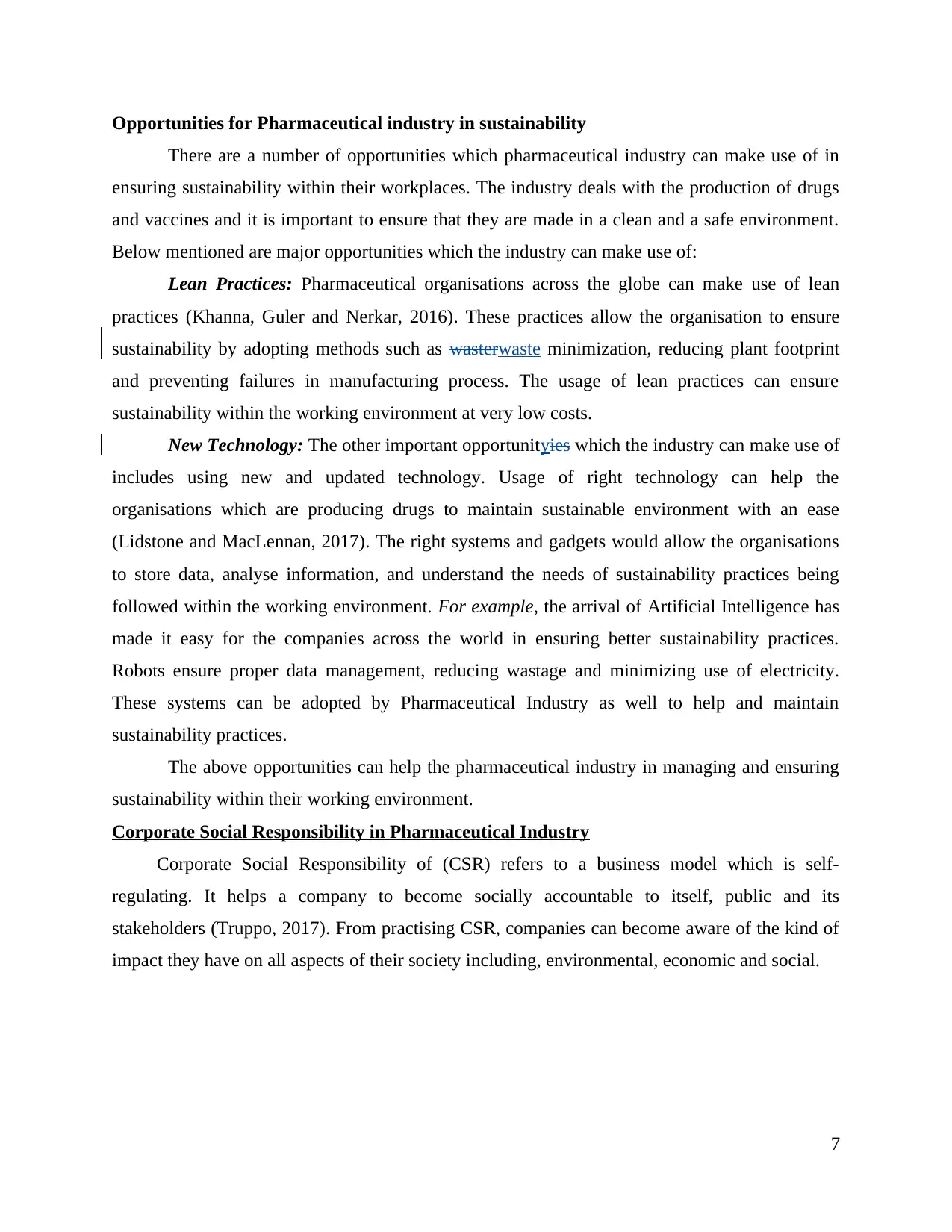
Opportunities for Pharmaceutical industry in sustainability
There are a number of opportunities which pharmaceutical industry can make use of in
ensuring sustainability within their workplaces. The industry deals with the production of drugs
and vaccines and it is important to ensure that they are made in a clean and a safe environment.
Below mentioned are major opportunities which the industry can make use of:
Lean Practices: Pharmaceutical organisations across the globe can make use of lean
practices (Khanna, Guler and Nerkar, 2016). These practices allow the organisation to ensure
sustainability by adopting methods such as wasterwaste minimization, reducing plant footprint
and preventing failures in manufacturing process. The usage of lean practices can ensure
sustainability within the working environment at very low costs.
New Technology: The other important opportunityies which the industry can make use of
includes using new and updated technology. Usage of right technology can help the
organisations which are producing drugs to maintain sustainable environment with an ease
(Lidstone and MacLennan, 2017). The right systems and gadgets would allow the organisations
to store data, analyse information, and understand the needs of sustainability practices being
followed within the working environment. For example, the arrival of Artificial Intelligence has
made it easy for the companies across the world in ensuring better sustainability practices.
Robots ensure proper data management, reducing wastage and minimizing use of electricity.
These systems can be adopted by Pharmaceutical Industry as well to help and maintain
sustainability practices.
The above opportunities can help the pharmaceutical industry in managing and ensuring
sustainability within their working environment.
Corporate Social Responsibility in Pharmaceutical Industry
Corporate Social Responsibility of (CSR) refers to a business model which is self-
regulating. It helps a company to become socially accountable to itself, public and its
stakeholders (Truppo, 2017). From practising CSR, companies can become aware of the kind of
impact they have on all aspects of their society including, environmental, economic and social.
7
There are a number of opportunities which pharmaceutical industry can make use of in
ensuring sustainability within their workplaces. The industry deals with the production of drugs
and vaccines and it is important to ensure that they are made in a clean and a safe environment.
Below mentioned are major opportunities which the industry can make use of:
Lean Practices: Pharmaceutical organisations across the globe can make use of lean
practices (Khanna, Guler and Nerkar, 2016). These practices allow the organisation to ensure
sustainability by adopting methods such as wasterwaste minimization, reducing plant footprint
and preventing failures in manufacturing process. The usage of lean practices can ensure
sustainability within the working environment at very low costs.
New Technology: The other important opportunityies which the industry can make use of
includes using new and updated technology. Usage of right technology can help the
organisations which are producing drugs to maintain sustainable environment with an ease
(Lidstone and MacLennan, 2017). The right systems and gadgets would allow the organisations
to store data, analyse information, and understand the needs of sustainability practices being
followed within the working environment. For example, the arrival of Artificial Intelligence has
made it easy for the companies across the world in ensuring better sustainability practices.
Robots ensure proper data management, reducing wastage and minimizing use of electricity.
These systems can be adopted by Pharmaceutical Industry as well to help and maintain
sustainability practices.
The above opportunities can help the pharmaceutical industry in managing and ensuring
sustainability within their working environment.
Corporate Social Responsibility in Pharmaceutical Industry
Corporate Social Responsibility of (CSR) refers to a business model which is self-
regulating. It helps a company to become socially accountable to itself, public and its
stakeholders (Truppo, 2017). From practising CSR, companies can become aware of the kind of
impact they have on all aspects of their society including, environmental, economic and social.
7
⊘ This is a preview!⊘
Do you want full access?
Subscribe today to unlock all pages.

Trusted by 1+ million students worldwide
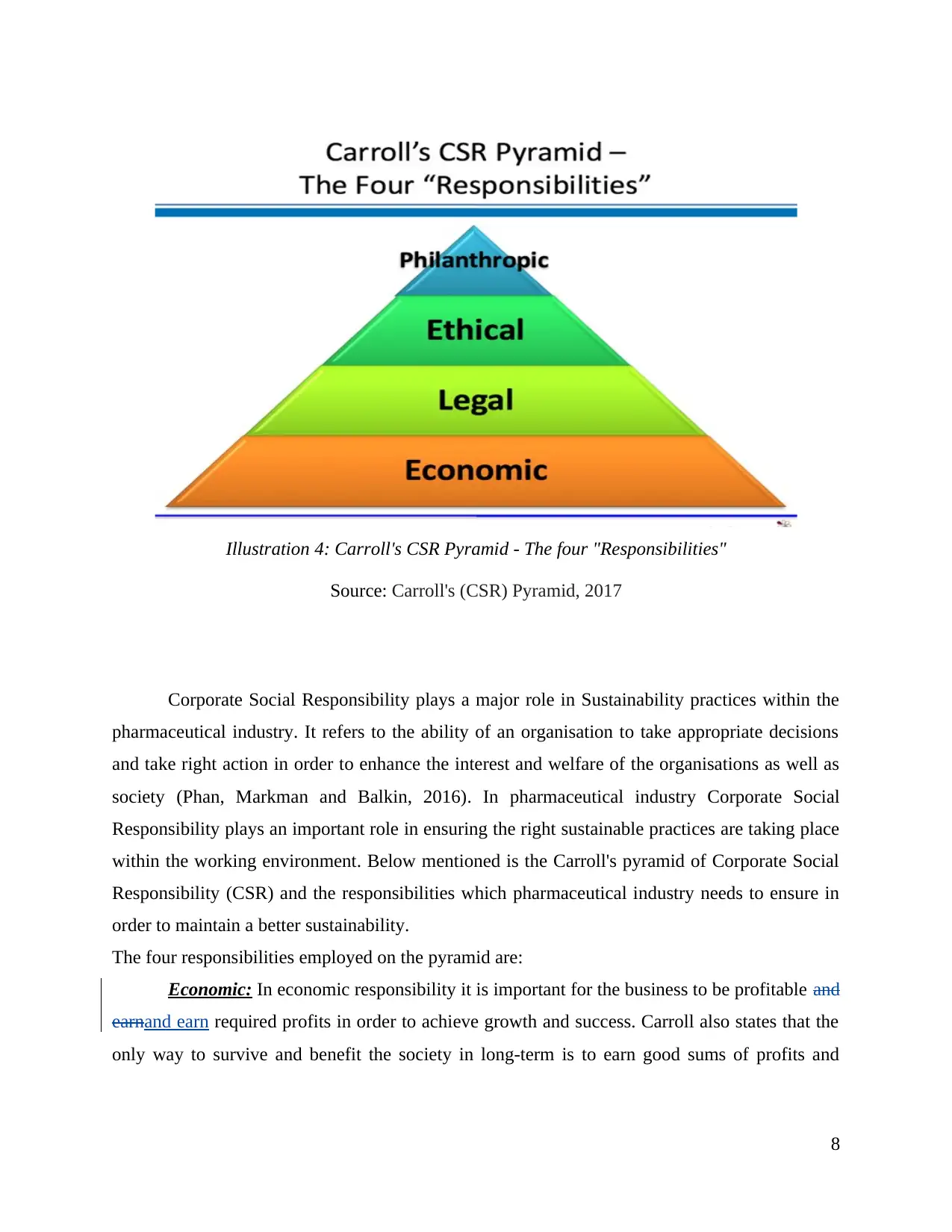
Corporate Social Responsibility plays a major role in Sustainability practices within the
pharmaceutical industry. It refers to the ability of an organisation to take appropriate decisions
and take right action in order to enhance the interest and welfare of the organisations as well as
society (Phan, Markman and Balkin, 2016). In pharmaceutical industry Corporate Social
Responsibility plays an important role in ensuring the right sustainable practices are taking place
within the working environment. Below mentioned is the Carroll's pyramid of Corporate Social
Responsibility (CSR) and the responsibilities which pharmaceutical industry needs to ensure in
order to maintain a better sustainability.
The four responsibilities employed on the pyramid are:
Economic: In economic responsibility it is important for the business to be profitable and
earnand earn required profits in order to achieve growth and success. Carroll also states that the
only way to survive and benefit the society in long-term is to earn good sums of profits and
8
Illustration 4: Carroll's CSR Pyramid - The four "Responsibilities"
Source: Carroll's (CSR) Pyramid, 2017
pharmaceutical industry. It refers to the ability of an organisation to take appropriate decisions
and take right action in order to enhance the interest and welfare of the organisations as well as
society (Phan, Markman and Balkin, 2016). In pharmaceutical industry Corporate Social
Responsibility plays an important role in ensuring the right sustainable practices are taking place
within the working environment. Below mentioned is the Carroll's pyramid of Corporate Social
Responsibility (CSR) and the responsibilities which pharmaceutical industry needs to ensure in
order to maintain a better sustainability.
The four responsibilities employed on the pyramid are:
Economic: In economic responsibility it is important for the business to be profitable and
earnand earn required profits in order to achieve growth and success. Carroll also states that the
only way to survive and benefit the society in long-term is to earn good sums of profits and
8
Illustration 4: Carroll's CSR Pyramid - The four "Responsibilities"
Source: Carroll's (CSR) Pyramid, 2017
Paraphrase This Document
Need a fresh take? Get an instant paraphrase of this document with our AI Paraphraser
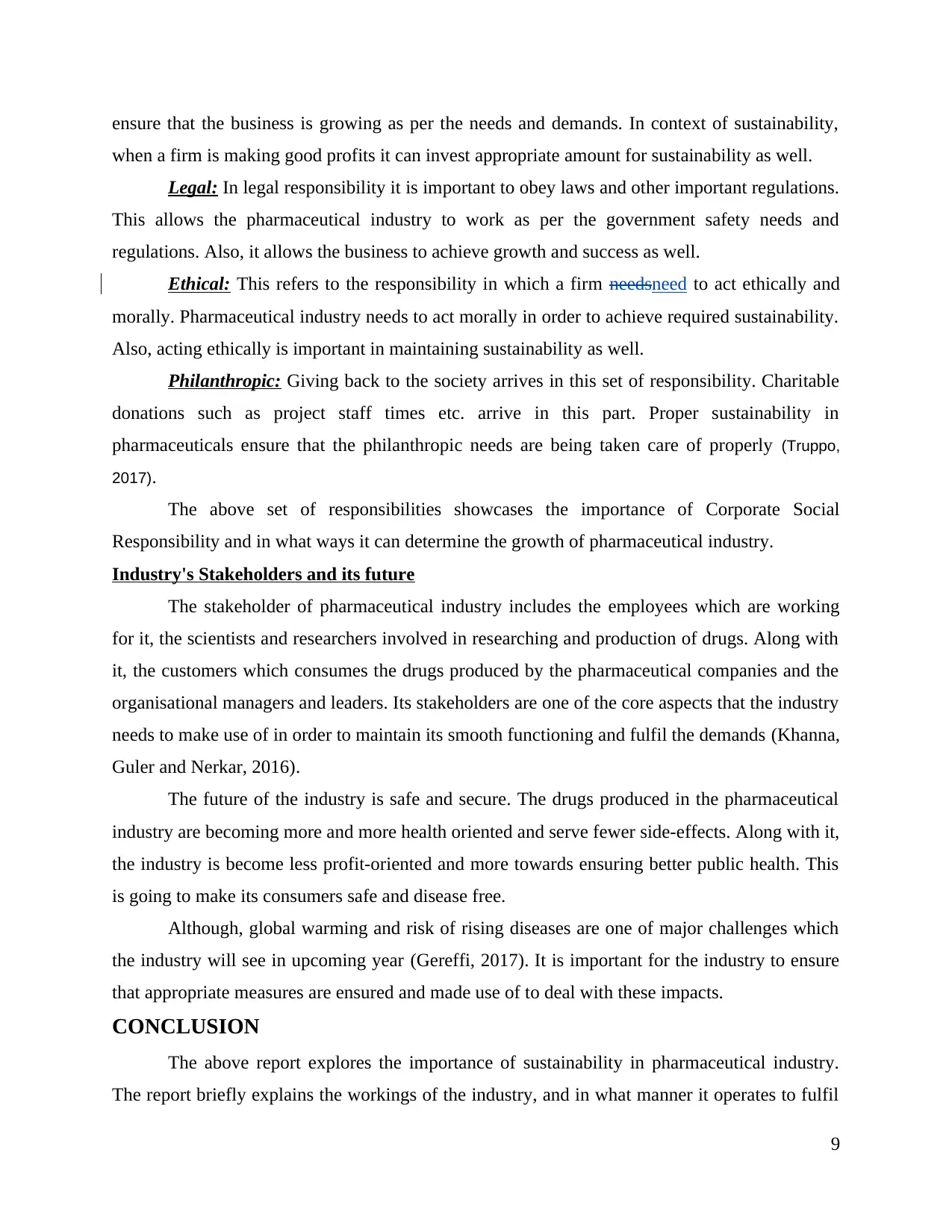
ensure that the business is growing as per the needs and demands. In context of sustainability,
when a firm is making good profits it can invest appropriate amount for sustainability as well.
Legal: In legal responsibility it is important to obey laws and other important regulations.
This allows the pharmaceutical industry to work as per the government safety needs and
regulations. Also, it allows the business to achieve growth and success as well.
Ethical: This refers to the responsibility in which a firm needsneed to act ethically and
morally. Pharmaceutical industry needs to act morally in order to achieve required sustainability.
Also, acting ethically is important in maintaining sustainability as well.
Philanthropic: Giving back to the society arrives in this set of responsibility. Charitable
donations such as project staff times etc. arrive in this part. Proper sustainability in
pharmaceuticals ensure that the philanthropic needs are being taken care of properly (Truppo,
2017).
The above set of responsibilities showcases the importance of Corporate Social
Responsibility and in what ways it can determine the growth of pharmaceutical industry.
Industry's Stakeholders and its future
The stakeholder of pharmaceutical industry includes the employees which are working
for it, the scientists and researchers involved in researching and production of drugs. Along with
it, the customers which consumes the drugs produced by the pharmaceutical companies and the
organisational managers and leaders. Its stakeholders are one of the core aspects that the industry
needs to make use of in order to maintain its smooth functioning and fulfil the demands (Khanna,
Guler and Nerkar, 2016).
The future of the industry is safe and secure. The drugs produced in the pharmaceutical
industry are becoming more and more health oriented and serve fewer side-effects. Along with it,
the industry is become less profit-oriented and more towards ensuring better public health. This
is going to make its consumers safe and disease free.
Although, global warming and risk of rising diseases are one of major challenges which
the industry will see in upcoming year (Gereffi, 2017). It is important for the industry to ensure
that appropriate measures are ensured and made use of to deal with these impacts.
CONCLUSION
The above report explores the importance of sustainability in pharmaceutical industry.
The report briefly explains the workings of the industry, and in what manner it operates to fulfil
9
when a firm is making good profits it can invest appropriate amount for sustainability as well.
Legal: In legal responsibility it is important to obey laws and other important regulations.
This allows the pharmaceutical industry to work as per the government safety needs and
regulations. Also, it allows the business to achieve growth and success as well.
Ethical: This refers to the responsibility in which a firm needsneed to act ethically and
morally. Pharmaceutical industry needs to act morally in order to achieve required sustainability.
Also, acting ethically is important in maintaining sustainability as well.
Philanthropic: Giving back to the society arrives in this set of responsibility. Charitable
donations such as project staff times etc. arrive in this part. Proper sustainability in
pharmaceuticals ensure that the philanthropic needs are being taken care of properly (Truppo,
2017).
The above set of responsibilities showcases the importance of Corporate Social
Responsibility and in what ways it can determine the growth of pharmaceutical industry.
Industry's Stakeholders and its future
The stakeholder of pharmaceutical industry includes the employees which are working
for it, the scientists and researchers involved in researching and production of drugs. Along with
it, the customers which consumes the drugs produced by the pharmaceutical companies and the
organisational managers and leaders. Its stakeholders are one of the core aspects that the industry
needs to make use of in order to maintain its smooth functioning and fulfil the demands (Khanna,
Guler and Nerkar, 2016).
The future of the industry is safe and secure. The drugs produced in the pharmaceutical
industry are becoming more and more health oriented and serve fewer side-effects. Along with it,
the industry is become less profit-oriented and more towards ensuring better public health. This
is going to make its consumers safe and disease free.
Although, global warming and risk of rising diseases are one of major challenges which
the industry will see in upcoming year (Gereffi, 2017). It is important for the industry to ensure
that appropriate measures are ensured and made use of to deal with these impacts.
CONCLUSION
The above report explores the importance of sustainability in pharmaceutical industry.
The report briefly explains the workings of the industry, and in what manner it operates to fulfil
9
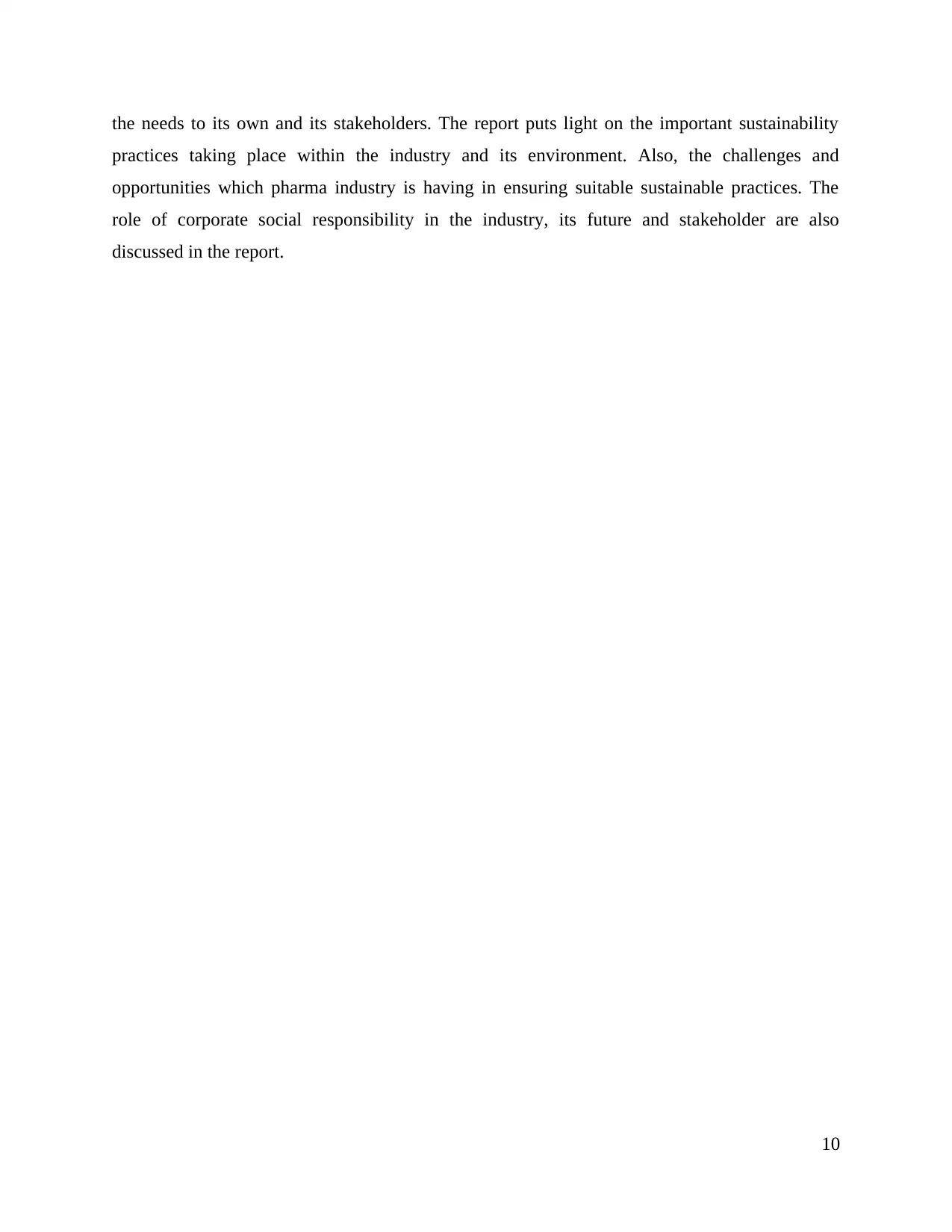
the needs to its own and its stakeholders. The report puts light on the important sustainability
practices taking place within the industry and its environment. Also, the challenges and
opportunities which pharma industry is having in ensuring suitable sustainable practices. The
role of corporate social responsibility in the industry, its future and stakeholder are also
discussed in the report.
10
practices taking place within the industry and its environment. Also, the challenges and
opportunities which pharma industry is having in ensuring suitable sustainable practices. The
role of corporate social responsibility in the industry, its future and stakeholder are also
discussed in the report.
10
⊘ This is a preview!⊘
Do you want full access?
Subscribe today to unlock all pages.

Trusted by 1+ million students worldwide
1 out of 14
Related Documents
Your All-in-One AI-Powered Toolkit for Academic Success.
+13062052269
info@desklib.com
Available 24*7 on WhatsApp / Email
![[object Object]](/_next/static/media/star-bottom.7253800d.svg)
Unlock your academic potential
Copyright © 2020–2025 A2Z Services. All Rights Reserved. Developed and managed by ZUCOL.





